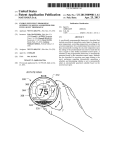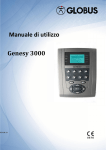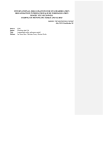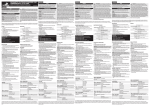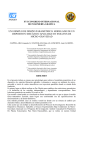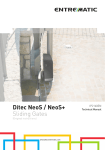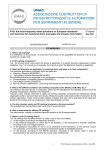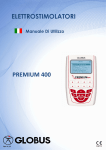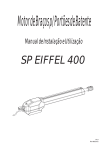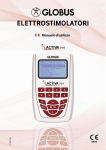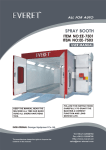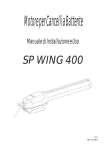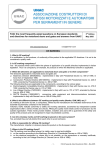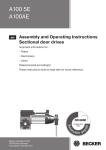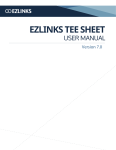Download Good Morning Cardin - Cardin Elettronica
Transcript
Good Morning Cardin _ Installation guide for automatic closing systems 2013 This digital palm device for measuring static and dynamic force, sums up and personifies our know how, and our desire to be better. The device confers the secure knowledge that every installation has been carried out in conformity with the European standards UNI EN12453 and UNI EN12445. Great force under control with feather light precision. WWW.CARDIN.IT INDEX INTRODUCTION AND AIM OF THE GUIDE RESPONSIBILITY AND LEGAL OBLIGATIONS WHAT HAS TO BE DONE: THE TECHNICAL FILE - RISK ANALYSIS - LIST OF COMPONENTS - MAINTENANCE REGISTER WHAT HAS TO BE DONE: THE CONFORMITY DECLARATION 4 4-5 5-7 7-8 8 8-9 WHAT HAS TO BE DONE: MARKING WITH THE SYMBOL THE SAFETY STANDARDS - THE NEW SAFETY STANDARDS - THE EN12453 STANDARD – REQUIREMENTS MINIMUM PROTECTION LEVEL FORCE LIMITATION MOTION SENSORS AND SAFETY DEVICES THE EN12445 STANDARD - TESTING METHODS 9-10 10-11 11 12 ATTACHED FORMS RISK ANALYSIS MAINTENANCE REGISTER THE CONFORMITY DECLARATION MAINTENANCE CONTRACT GUARANTEE CONDITIONS 14-15 16-17 18 19-20 19-20 Conforms to UNI EN 12453 and UNI EN 12445 4 | I N S TA L L AT I O N G U I D E INTRODUCTION The declaration of conformity, that the installer fills out and leaves with the end user after he has added an automatic device to an already existing manual apparatus, attests that the automatic closing device conforms to the relevant directive (in particular the Construction Products Directive 89/106/CE and to the current version of the machine directive 2006/42/CE) as well as to the European technical standards, above all the standard EN 13241-1 regarding industrial and commercial closing devices operating garages and gates whether they are manual, motorized or automatic. Note: all the directives that are mentioned in this manual have been accepted in Italy with Presidential approval or other legal apparatus. The aim of these directives and standards is to define the technical, constructive and operative characteristics and the testing methods for the devices which make up the automatic system and that act as a safeguard against risks which could occur during the operative life of the system. They therefore deal with safety aspects Before confronting the purely technical standards we would remind the installer of what he must do to be considered ‘within the rules’. AIM OF THIS GUIDE 1. To supply fundamental information regarding the regulations, legal obligations and responsibility for a safe automatic closing installation for domestic, industrial or commercial use; 2. To supply concrete technical support to simplify and directly satisfy all the requirements foreseen by the laws and reference standards. RESPONSIBILITY The law states that the person responsible for the safety of an automatic closing installation is the same person who carried out the initial installation. The installer has the complete responsibility regarding the following: • the correct installation of the system carried out according to the standards in force and following the installation instructions supplied by the constructor of the component parts of the automatic closing installation; • the use of approved materials (certified) which conform to the laws and reference standards covered by the trademark. To this end the installer must attach the certificates and/or the declaration of conformity to the instruction manual of the component parts of the automatic closing installation. • handing over documents to the client which contain the following: - the operating instructions and warnings for the safe use of the system; - normal periodic maintenance instructions; - the declaration of approval; - the maintenance register. LEGAL OBLIGATIONS The European community commission has declared that all automatic closing systems (motorised gates and doors etc.) are governed by the Machine Directives (2006/42/CE) (1). This directive states that the installer who "motorises" a gate or a door (therefore creating an installation) has the same obligations as the constructor of an automatic machine and therefore must: 1. prepare the technical file; 2. fill out the declaration of conformity (2); 3. apply the symbol to the automatic closing system. I N S TA L L AT I O N G U I D E | 5 Note (1) • already in the earlier version of the machine directive (89/392/CEE) adding automation to a new manual closing system made it a machine, and therefore the person who carries out the transformation must respect the machine directives; • the definition of a 'machine' according to the Machine Directive 2006/42/CE: - an assembly, fitted with or intended to be fitted with a drive system other than directly applied human or animal effort, consisting of linked parts or components, at least one of which moves, and which are joined together for a specific application; - an assembly referred to in the first indent, missing only the components to connect it on site or to sources of energy and motion; - an assembly referred to in the first and second indents, ready to be installed and able to function as it stands only if mounted on a means of transport, or installed in a building or a structure; - assembly of machinery referred to in the first, second and third indents or partly completed machinery (see below) which, in order to achieve the same end, are arranged and controlled so that they function as an integral whole; - an assembly of linked parts or components, at least one of which moves and which are joined together, intended for lifting loads and whose only power source directly applied is human effort. • Definition of ‘partly completed machinery’: ‘partly completed machinery’ means an assembly which is almost machinery but which cannot in itself perform a specific application. A drive system is partly completed machinery. Partly completed machinery is only intended to be incorporated into or assembled with other machinery or other partly completed machinery or equipment, thereby forming machinery to which this Directive applies; • two other EU directives, Electromagnetic compatibility (2004/108/EC) and low power devices (2006/95/EC), indicate the guidelines for the minimum safety requirements of machinery that is already being used. Note (2) - The conformity of a product is declared according to a directive, which defines the essential requirements that are to be respected. The technical standards are fundamental instruments for guaranteeing that the product conforms to the essential requirements of the directive. By affixing or having affixed the marking, the manufacturer indicates that he takes responsibility for the conformity of the product and declares that it conforms to the essential requirements of all the directives effecting that product and that correct procedures for evaluating the conformity of the product have been carried out. WHAT HAS TO BE DONE: THE TECHNICAL FILE The automatic closing system technical file that the installer has to fill out and save must contain the following indications: • complete mechanical and electrical drawings; • risk analysis of the closing system and the solutions used; • the technical manuals for each single component (with installation and maintenance methods and details); • the list of components used (with their declaration of conformity (3) and the declaration of incorporation of the party completed machinery); • the operating instructions and general warnings for a safe installation are to be given to the end user; • the maintenance register for the system is to be given to the end user; • the declaration of conformity with the Machine Directive for the system is to be given to the end user. Note (3) In the declaration of conformity / incorporation you must indicate the directives to which the product conforms (see also note 2) and the technical reference standards used for its construction. 6 | I N S TA L L AT I O N G U I D E RISK ANALYSIS Possible risks, which can appear when using an automatic closing system and the solutions used to reduce or eliminate them, are listed in the attached sheets. To carry out correct risk analysis the following points should also be considered. • check the constructive and mechanical condition of the closing system that is to be automated (door, gate, etc.) and coordinate any eventual interventions required to obtain the correct and regular operation of the closing device working manually; • evaluate the risk level presented by the closing device remembering that different levels of risk can be assigned to the same danger point); risk is in fact the combination of the probability which occurs in dangerous situations (which increases with the number of users) with the graveness of the consequences; • typical dangers associated with automatic closing are: Bangs Crushing Shearing Wedging Dragging Cuts Hooking COMPONENT LIST Made up of a list of components and accessories used to carry out the automatic closing installation. The technical characteristics and the installation, use and maintenance instructions for the products can be found in their relative documentation supplied by the manufacturer of the product/s. MAINTENANCE REGISTER The maintenance register (as well as indications relating to the client, the closing system and the installer, the list of components used and the residual risk indications) contains a a list of installation activity, maintenance interventions repairs and modifications carried out throughout its lifetime; it must be available for inspection by authorized bodies where required. The new harmonized standards highlight the fact that maintenance is of fundamental importance in ensuring that the automatic closing system remains efficient, without undesired blocks and guarantees its safety (4). During maintenance interventions (5) all necessary actions must be taken to check that the closing system corresponds to the operational and safety conditions at the time of the initial installation; the following must be checked for example: • limits of force must be respected if the safety of the automatic closing system is guaranteed by a torque system (see standards EN12453 and EN12445); • detection devices with direct safety functions, type E, or only courtesy functions, type D, must function correctly (see standard EN12445). rawing number : DM0672 Note (4) Maintenance obligations roduct Code : Normative Description : ANALISI DEI RISCHI Law decree 81/2008 – entirely dedicated to safety aspects – refers to maintenance as a general safeguard; 18-05-02 raft : P.J.Heath Article 15 ofDate the :decree imposes the “regular maintenance of equipment, machinery and installations”. ARDIN ELETTRONICA S.p.A - 31020 San Vendemiano (TV) Italy - via Raffaello, 36 Tel: 0438/401818 Fax: 0438/401831 I N S TA L L AT I O N G U I D E | 7 Note (5) The maintenance technician must carry out periodic maintenance interventions not only respecting the indications of the various constructors of the installed components (regarding both the time of the intervention as well as the frequency of intervention to be carried out) but also respecting the indications noticed by the installer himself (in fact the installer is aware of where the installation is located, the ambient conditions and what it is being used for). It is evident that a maintenance contract must be stipulated containing at least the following: • the personal Date of the contractor and the client; • the binding period, prices, payment methods and eventual renewal terms; • the frequency of ordinary maintenance interventions; • the operations / checks that are carried out on the installation (meaning the closing system and its inherent components) during periodic maintenance interventions; • the methods to be followed when replacing components (due to failure or wear); • the intervention management method (on call or extraordinary maintenance interventions)"; Notes: as a follow up to the Directive 99/44/CE coming into force which regulates the relationship between the seller and the customer regarding the “conformity and guarantee of consumer goods” (relationships between the professionals, meaning the manufacturer of the product, the dealer and the installer are therefore excluded), the installation is now considered a product in the category of consumer goods and is therefore subject to the enacted laws of that directive. The installer is responsible and therefore must answer to the client (for two years from the supply of the closing system) not only for the conformity of the installation (i.e. for having carried out a competent installation and for having respected the installation instructions) but also for the conformity of the products used in the construction of the automatic closing system. He could claim from the constructors of the products for the used parts remembering however that: • the duration of the guarantee may also be limited by the maximum number of manoeuvres that can be carried out without maintenance interventions (as stipulated by the constructor and laid out in the instruction manual); • generally the guarantee is not valid in cases of product non-conformity owning to situations where constructive defects cannot be held responsible. In the articles of titles I, II and III of Part IV ‘security and quality’ of the consumer protection code, Law decree 6 September 2005 nr. 206 there are important indications regarding product safety, faults and conformity guarantee of consumer goods. WHAT HAS TO BE DONE: THE DECLARATION OF CONFORMITY The conformity declaration, meaning the conformity of the complete installation, and the procedures used by which the “constructor” (in this case the installer who assembles the automatic closing system) declares that the “machine” respects all the essential safety requirements, which effect it and that it has been installed correctly according to the standards and regulations in vigour. Signing the conformity declaration authorises the “constructor” (in this case the installer) to attach the mark to the machine. The directives, which must be indicated in the declaration, are as follows: • Machine directive – version 2006/42/CE; • Electromagnetic compatibility directive (EMC) – version 2004/108/CE; - Construction products directive (CPD) – version 89/106/CEE; - And if required, the Radio and Telecommunications Terminal Equipment directive (R&TTE) – version 99/05/ CE. Conforming with the above mentioned directives does not exclude the obligation to conform with other technical standards and local laws e.g. the Directive 99/05/CE – regarding radio devices and telecommunications terminals – and law decree 37 dated January 22nd 2008, the new 46/90). 8 | I N S TA L L AT I O N G U I D E By signing the conformity declaration the installer (constructor) of the automatic closing system assumes the following responsibilities: - the responsibility for the installation and how it was carried out by the declarer; - the responsibility for eventual modifications being carried out by qualified technicians authorised by the declarer; - the responsibility for the installation being maintained following indications supplied by the declarer “as the constructor of the closing system” and by the producers of the components used. You are advised to include in the Declaration of Conformity any activities carried out before fitting the automation to the closing device e.g. any operation carried out to the structure to guarantee the solidity and stability of the closing system or other assessments such as the lack of the marking on the manual closing system etc. WHAT HAS TO BE DONE: THE MARK The following is a list of Date that has to be included (indelible and easily readable) in the marking of the automatic closing system: - name and address of the constructor - last two digits of the year of construction - European standards - description of the product and what it will be used for (e.g. automatic sliding gate) - identification number that links the closing device to its technical file - information regarding the regulated characteristics of the product - the mark - the directives to which the product conforms AAAAA, PO Box 21, B-1050 01 EN 13241 – 1 Automatic closing system Identification number Resistance to water Resistance to wind Resistance to heat Resistance to air npd 2 npd npd (89/106/CEE; 2006/42/CE; 2004/108/CE) THE SAFETY STANDARDS Note: since the withdrawal of UNI 8612 on May 1st 2001 the technical standards that regulate the automatic closing device sector are: - the safety standards UNI EN 12453 and UNI EN 12445 - the standards regarding safety devices UNI EN 12978 (part of UNI EN 12453) - the “mechanical standards” UNI EN 12604 and 12605 - the standards for installation and use UNI EN 12635 The legal references regarding the finished automatic closing system were only represented by the Machine Directive (the current version is 2006/42/CE) until 2005, when the product standard UNI EN 13241-1 became legal for industrial and commercial closing systems for garages and gates which allowed the Construction Products Directive (the 89/106/CEE) to be effectively applied to the closing system and consequently the obligation for marking for the closing system whether they be automatic or manual. We would remind you that the other directives aimed specifically at products used in the automation of closing devices: the Electromagnetic Compatibility Directive (2004/108/CE), The Low Power Device Directive (2006/95/CE) and in particular, where the case may be, the R&TTE directive (99/05/CE) for Radio and Telecommunications Terminal Equipment (radio control devices). The UNI EN 12453 standards and UNI EN 12445 are particularly significant because they are based on the analysis of danger situations; they cover safety aspects and are laid out in the form of safety objectives; the methods and the solutions proposed should not be considered to be the only method for satisfying the requirements of the standards and in fact other solutions which provide an equivalent level of safety are allowed. I N S TA L L AT I O N G U I D E | 9 Note: effectively reaching the safety objectives using different solutions from those indicated by the UNI EN 12453 will allow you to compile the Conformity Declaration; in this case however there is even greater reason for you to indicate the solutions used to eliminate and/or reduce the risks in the technical file to clearly indicate that the objectives have been reached. THE EN12453 STANDARD – REQUIREMENTS If we start from the principal that when a closing system is automated it automatically becomes a machine, the EN12453 deals with the closing system safety problems as if it were dealing with a typical machine, that is to say it begins with risk analysis; the next step is to put these measures into force in order to eliminate or reduce as much as possible the risk level associated with the danger situations that have been detected. This can be obtained through the following concepts: - minimum protection level; - force limitation; - presence detection and safety devices. It is important to remember that different risk levels can be associated with one single danger situation (risk in fact is the combination of the probability that the danger situation will arise and the graveness of the consequences). It is evident for example that the risk level rises: - when the closing system is used by a great number of people; - when those people cannot be trained; - when it is not possible to limit the use of the closing system to an authorised group of people. The standard EN12453 takes all this into account when defining the safety measures that should be adopted depending on the outcome of the risk analysis. MINIMUM PROTECTION LEVEL The minimum protection level required by the standard for the main edge of the closing system depending on the command type and the use of the closing system is laid out in the following table taking into account that: • The types of use of the closing system are divided into three groups: 1) A limited number of people are authorised to use the closing system and it is not in a public area. Typical examples are closing devices within apartment blocks (excluding doors that open on to public streets), the use of which has been taught to the users. 2) A limited number of people are authorised to use the closing system and it is in a public area. (external area of apartment blocks and on company premises). 3) Any person can use the closing system and it is situated in a public area. • The letters A, B, C, D, E indicate the type of protection that is to be used: A: Manual command button (i.e. manually held down); B : Manual command using a selector switch to impede use by non-authorised persons; C : Force limitation; D : Obstacle or person detection device; they can be applied to either side or to both sides of the door (for example photoelectric cells); E : Presence detection devices that are designed and installed in such a way that under no circumstances can a person be touched by the gate or door in movement (no contact detection devices). Typical examples are pressure mats or photoelectric beams. These detection devices must cover the entire danger area. 10 | I N S TA L L AT I O N G U I D E Note: The danger area is defined as the volume containing the gate or door in any position it can reach during movement increased by the safety distance “d” in all directions and up to a height of 2,5 metres. The safety distance “d” depends on the speed of the gate/door; it must not however be inferior to 200 mm but, if the closing speed of the gate/door is greater or equal to 0,5 m/s, “d” must be at least 900 mm. TYPE OF ACTIVATION OF THEUSE OF THE CLOSING SYSTEM CLOSING SYSTEM Expert personExpert personUnlimited use Command (outside a public area) (public area) (public area) Group 1Group 2Group 3 using a hold down using a key and holding Manual button (A) it in position (B) Impulse commands with the force limitation (C) a force limitation (C) / force limitation (C) / closing system in sight photoelectric cells (D) / or a safety device (E) or a safety device (E) (infrared command) safety device (E) Impulse commands with the force limitation (C) / closing system not in sight or a safety device (E) (radio controls) Automatic force limitation (C) and photoelectric cells (D) / safety device (E) force limitation (C) and photoelectric cells (D) / safety device E) force limitation (C) and photoelectric cells (D) / safety device (E) force limitation (C) and photoelectric cells (D) / safety device (E) force limitation (C) and photoelectric cells (D) / safety device (E) FORCE LIMITATION The force limitation of gate/door opening or closing is a typical aspect of the standards; the drawing below shows the profile of the impact force detected on the main edge of the closing system using the instrument indicated by the standard EN12445, which also indicates the points of measurement and how they should be carried out. Dynamic force Static force Fd 1400N gate/door force measured over time 400N Fs 150N 25N T0 Td Ts time There are four significant parameters: • Dynamic force Fd, i.e. the surge of the profile of the detected force must be less than the value shown in the underlying table (depending on the type of closing system and the passage opening); I N S TA L L AT I O N G U I D E | 11 • dynamic time Td must be inferior to 750 ms; Td represents the time during which the measured force exceeds 150 N (the normal translation force value); • static force Fs, i.e. the force that remains after the dynamic time Td,, it must not however be greater than 150 N; • final force Fe, i.e. the force that remains 5 seconds after the start of the measurement (Td + Ts), it must not be greater than 25 N. BETWEEN CLOSING BORDERS AND OPPOSITE BORDERSBETWEEN FLAT AREAS PERMITTED surface area > 0,1m2 openings of openings of SURGE FORCE and sides ≥ 100 mm 50 to 500 mm >500 mm Closing systems with horizontal (sliding) movement 400N 1400N 1400N 400N 1400N 1400N Closing systems with vertical movement (fold-up doors) 400N 400N 1400N Closing systems rotating on an axis parallel to the pavement (garage doors/road barriers) 400N 400N1400N Closing systems rotating on an axis perpendicular to the pavement (hinged doors) PRESENCE DETECTION AND SAFETY DEVICES Presence detection and “safety devices” regard closing systems where the safety is delegated to force limitation; the classic photocells with one or two modulated beams are relegated to a secondary or courtesy form (type D devices) according to the standard EN 12453, as they avoid people from being hit by the gate/door if they interrupt the beam but are not considered safety devices (guaranteed by force limitation). When the detection devices have a true safety function in the sense that the safety of the system depends entirely on their correct operation, they are considered to be type “E” safety devices and it is evident that their characteristics and the severity of the test they will undergo to check the conformity is definitely going to be greater than the tests for type “D” devices. As well as this the devices that carry out safety functions must satisfy the “resistance to failure” (UNI EN 12978) requirements and the presence detection area must encompass the entire danger zone. The standard EN12453 obliges you to avoid danger situations caused by single failures both when the safety is guaranteed by force limitation (case C) as well as when you are using presence detection (case E). You obviously need to take into account that the failure you could occur both in the sensitive element itself (e.g. a pressure contact safety edge or a photoelectric beam) as well as in the signal’s control circuit (from the sensitive device to the ECU that controls the movement of the gate/door). It is possible to make sure that a single failure does not reduce the safety level of the system in two ways: • By duplication of the parts that are open to failure so making sure that the security function remains active even in case of failure; • By periodically monitoring the correct operation of the safety devices. The standard requires that safety function test be carried out before the gate/door starts moving or a later during the final movement of the device and if a failure is detected any movement of the gate/door must be inhibited. 12 | I N S TA L L AT I O N G U I D E The safety device are covered by the standard EN12978, regarding the functions of pressure sensitive devices (e.g. sensitive edges or sensitive mats) or electro-sensitive devices (e.g. infrared devices such as the classical photoelectric cells) and refer to UNI EN ISO 13849-1 (the new UNI EN 954-1). THE STANDARD EN12445 – TEST METHODS • The indications regarding how to measure force: where they should be carried out and the characteristics of the measurement instruments (three measurements must be made at each point; the average value must satisfy the requirements); • The procedure and the methods for checking the correct position of type “D” and “E” presence detectors and verifying their correct functioning is established by the use of witness objects (two types) that represent the human body: - Calibre A: a rigid parallelepiped 70 cm x 30 cm x 20 cm; - Calibre B: a rigid cylinder length 30 cm and diameter 5 cm. For closing systems fitted with one or more type “D” detectors the standards only require checks made with calibre “A”. To check the efficiency of a type “E” detection device both of the calibres (“A” and “B”) must be used. The test details depend on the type of closing system but the gate/door must stop moving or invert its sense of travel direction (avoiding danger situations) without the gate/door and the calibre coming into contact. The detection area of the device must cover the entire danger zone of the closing device. I N S TA L L AT I O N G U I D E Regulations make us stronger. And safer. _ When a gate closes, a new chapter opens. Dedicated to safety. It is in fact, only after all the checks and measurements have been carried out, that the work is deemed complete and the Cardin product can take its place in the world. Knowing that it is built to be safe brings a certain pride. This is the prize that awaits us after every installation. | 13 Installation / maintenance / assistance company: RISK ANALYSIS The dangers/risks indicated below are those most commonly found in automatic closing installations; it is therefore necessary to take into consideration additional dangers/risks that could occur in specific situations and to exclude those which are not applicable. The dangers/risks that have been detected and which do not appear below must be added to this document or included in an annex to this document along with the solutions used to resolve the situations. Types of risk (Mark the risks considered) Evaluation criteria and solutions used (tick the box corresponding to the solution used) Mechanical and structural risks and wear and tear loss of stability The robustness of the structure has been checked, suitable materials and fastenings have been used. falling parts Required interventions and adjustments have been carried out to make sure the gate leaves cannot fall. protrusions Checked that protrusions greater than 4 mm (e.g.. the gate runner guide) have been rounded and highlighted. slippery surfaces Checked that protrusions do not have slippery surfaces or could become slippery when it rains. Checked the presence and efficiency of an anti-falling system for the moving parts. Suitable travel limits have been installed and checked. The necessary maintenance instructions have been supplied. Further checks The moving parts have been fitted with enough protection according to the standards in force and have been installed following the manufacturer’s instructions. If required and according to the manufacturer’s instructions, the speed adjustment of the gate leaf can only be carried out by specialised personnel. The gate has been fitted with a release device to allow manual operation. The opening has been checked to verify that there are no assembly errors. Suitable instructions have been supplied to carry out the manual release. Suitable instructions explaining how to avoid unforeseen or non wanted start ups (e.g. during maintenance interventions) have been supplied. Risks caused by movement of the closing system Risk type A) bangs/ crushing D) dragging / wedging B) cuts E) shearing C) lifting F) hooking Solutions adopted Protection to be applied 1) manual commands 8) multiplex barriers (protective devices) 2) safety edges (protective devices) 3) photoelectric cells (detection devices) 9) acoustic signals 4) safety devices 11) warning signs 5) torque adjustment (protective devices) 12) separation (using covers or rubber buffers) 6) rounding the surfaces 13) wire mesh protection 7) safety mats (protective devices) 14) other 10) warning lights The forms are supplied by Cardin Elettronica S.p.A to facilitate the fulfilment of the obligations required by law and the company does not except any responsibility for incorrect, incomplete or erroneous compilation. Installation / maintenance / assistance company: RISK ANALYSIS Safety and reliability of the operator and the command devices safety conditions (even during failure and blackouts). Suitable command, movement and safety devices have been used which conform to the standard EN12453 (chapter 5 and appendix A). Command devices fitted with buffer batteries which conform to the standards and regulations in force have been installed. The installation has been carried out following the indications in the installation manual. assembly errors and command coherence command devices The commands are coherent with the movement of the closing automation and with the instructions supplied by the constructor. An emergency stop device has been installed (and doesn’t introduce added risk). The command devices have been installed in a visible and easily accessible position. measuring the force of the closing device Measurements have been carried out using instruments according to the standard EN 12445 and at the correct points (chapter 5). proximity protection devices (contact between the closing system and people must never be allowed) A detection device which confirms to the standard EN 12978 has been installed. detection devices Checks have been carried out to the detection device according to the standard EN 12445. Principles for integrating safety devices and information residual non protected risks The user has been informed that residual non protected risks remain and that foreseeable incorrect use of the installation has been communicated. warning devices Warning lights, traffic lights and sirens etc. have been installed in correct and easily visible positions. warning signs Warning signs indicating residual risk have been positioned. marking An adhesive or plaque with the CE marking and containing the constructor’s Date, the address, series, type of closing device and the installation year has been fitted. User manual and safety instructions have been given to the end user. user instructions Keys and tools for manual release etc. have been supplied. The commands have been situated in easily accessible positions. Electrical risks direct and indirect contact Components marked with the CE symbol according to the Low Voltage Directive (2006/95/EC). electrical energy dispersion The electrical connection and connection to the mains conforms to the standards in force and is in agreement with the instructions supplied by the constructor. Electromagnetic compatibility risks Approved radio control devices or those conforming to the directive R&TTE (99/5/CE) with allowed frequencies, according to the relative standards, have been used. electrical, magnetic and electromagnetic field emission Components marked with the CE symbol according to the EMC (2004/108/CE) directive have been used. The installation follows the instruction manual for the operating device and for other eventual electrical and electronic components. Ergonomic risks force required for manual movement Check that the manual movement commands do not require excessive force and conform to the standard EN12604 (manual gate opening/closing using force not greater than 150N if in a residential area or 260N if in a commercial/industrial area) and to the standard EN12453 chapter 5.3.5. Maintenance how to proceed A maintenance plan has been drawn up and put into act for the required time period (at least once every 6 months) maintenance contract. power supply cut off devices A cut off device has been installed to interrupt the electrical power supply. documentation Maintenance interventions have been registered and the CE declaration of conformity has been given to the end user. The forms are supplied by Cardin Elettronica S.p.A to facilitate the fulfilment of the obligations required by law and the company does not except any responsibility for incorrect, incomplete or erroneous compilation. Installation / maintenance / assistance company: MAINTENANCE REGISTER The following maintenance register contains the technical references, installation, maintenance, repair and modifications carried out, and must be made available for inspection by authorised bodies where required. Client: (Name, address and reference person) Description of the gate/door closing device: (Model, type) Identification number: Location: Gates/doors: Power supply: Installer: (Address) (Number, material, dimensions, weight) Operating type: (Voltage and electrical input) (Name, address, telephone) (Manual, semi-automatic, automatic) Installation date: List of installed components (drive unit, command and safety devices) The technical characteristics and performance of the below mentioned components has been laid out in their relative installation manuals and/or on the technical Date plate. Drive unit: Motor: ECU: Photocells: Safety devices: Warning lights: Radio controls: Command device: Other: (Type) (Serial number) (Type) (Serial number) (Type) (Serial number) (Type) (Serial number) (Type) (Serial number) (Type) (Serial number) (Type) (Serial number) (Type) (Serial number) (Type) (Serial number) Indications regarding residual risk factors and foreseen improper use Warning signs placed at the points of risk of the system and/or written indications explaining the risk factors and improper use should be given to the user of the gate End user’s signature Installer’s signature The forms are supplied by Cardin Elettronica S.p.A to facilitate the fulfilment of the obligations required by law and the company does not except any responsibility for incorrect, incomplete or erroneous compilation. MAINTENANCE REGISTER Date: Technician’s signature : End user’s signature : Technician’s signature : End user’s signature : Technician’s signature : End user’s signature : Technician’s signature : End user’s signature : Technician’s signature : End user’s signature : Technician’s signature : End user’s signature : Intervention description: Date: Intervention description: Date: Intervention description: Date: Intervention description: Date: Intervention description: Date: Intervention description: The forms are supplied by Cardin Elettronica S.p.A to facilitate the fulfilment of the obligations required by law and the company does not except any responsibility for incorrect, incomplete or erroneous compilation. Installation / maintenance / assistance company: CONFORMITY DECLARATION The undersigned: Name Address Manufacturer of the automatic closing system and person responsible for the start up of the system declares that the product: Description Type Serial number Location conforms to the requirements of the following EC directives: Construction Products Directive 89/106/EEC Machine Directive 2006/42/EC Electromagnetic compatibility Directive 2004/108/EC R&TTE Directive 99/05/EC I also declare that the harmonised standards and/or specific technical standards: EN 12604: Industrial gates and doors, commercial and domestic - Mechanical aspects- Requirements and class EN 12605: Industrial gates and doors, commercial and domestic - Mechanical aspects - Testing methods EN 12453: Industrial gates and doors, commercial and domestic - Safety when using motorised doors - Requirements EN 12445: Industrial gates and doors, commercial and domestic - Safety when using motorised doors - Testing methods Attached: the technical file Place Date The client (on receipt) The declarant The forms are supplied by Cardin Elettronica S.p.A to facilitate the fulfilment of the obligations required by law and the company does not except any responsibility for incorrect, incomplete or erroneous compilation. Installation / maintenance / assistance company: MAINTENANCE CONTRACT CLAUSES OBJECTIVE: guarantee that the automatic opening system functions correctly and safely throughout time. The following is a list of clauses that the you are advise to insert into the contract that the contractor (the installation/ maintenance company) offers to the client 1. Establish the frequency of the preventative maintenance interventions (every ____ months) and the number of “installations” (also establish the type of installation); 2. Indicate what to do to replace defective components or components that do not guarantee the correct working order of the system (e.g. only the cost of the replaced components will be charged and for labour costs you need to consult the prices in force (for the association of installers in your country) at the moment of the intervention; 3. The same goes for repair work requested outside of the normal scheduled maintenance program (e.g. these requests will be considered outside of the present contract and will be charged according to the prices established by the installer’s association in your country. For each intervention the contractor will charge (other than the time taken according to the price lists mentioned above and the cost of the components) a default fee for the requested intervention fixed at Euro ______); 4. Establish the duration of the service offered (e.g. two years) and how to renew it (e.g. year by year by tacit agreement); also establish the method of giving notice whereby one of the two parties may cancel the maintenance service; 5. Establish the fee (excluding VAT) and the payment method (e.g. once the intervention has been carried out or in advance) and if travel costs are included or not (in this case make reference to the official tables establishing reimbursement for the number of kilometres travelled); 6. Eventual reasons why the contractor can consider the contract no longer valid and interrupt the service (e.g. in cases where the client has not paid for the agreed services the contractor company can deem the contract to be null and void and therefore interrupt the service, also in cases where maintenance interventions have been carried out by other companies which also leads to the renunciation of all responsibility); 7. Indicate that the contractor cannot be held responsible for installation defects or defective repair work arising from previous work carried out by other parties (hidden defects); 8. Other conditions where the Contracting Company has been freed of all obligation to carry out maintenance services or to replace damaged parts as covered by the special conditions in points 2 and 3 (e.g. in cases where the defect is due to accidents, negligence or incorrect use of the mechanisms or any other defects deriving from: breakage, failure caused by vandalism, attempted burglary, atmospheric phenomena etc.); 9. Indicate for example that the maintenance contract does not include technical interventions sand replacement of broken parts due to failure caused by the installation of additional devices or tampering caused by personal not authorized by the Contracting Company. Any eventual special servicing of the automation will be estimated and billed separately from the ordinary maintenance work; 10. Attach the list of operations to be carried out during the foreseen maintenance operations to the programmed maintenance contract (see following page); 11. Complete the documentation with the Date, Location and signature of both the contractor and the client for example: Location Date The client (on receipt) The declarant The forms are supplied by Cardin Elettronica S.p.A to facilitate the fulfilment of the obligations required by law and the company does not except any responsibility for incorrect, incomplete or erroneous compilation. Installation / maintenance / assistance company: PROGRAMMED MAINTENANCE CHECKS: General visual inspection Check the stability of gates/doors Check hinges / pivots Check plates with guide rollers Check sliding wheels Check tightness of nuts and bolts Check photocell activation/intervention Check safety edges functioning Check warning lights Check torque limiters functioning Check command functions Check radio controls Check movement chains Check closing electric locks Check the electrical connection Check electronic control unit Check mechanical attachments Check for abnormal noise Check manual release system Lubricate pivots / articulations Appliance’s state of cleanliness Check for regular movement Check when the control/work has been carried out (X) NOTE: REPLACED MATERIALS: Sign on receipt (client) SN0002. app 7 / 04/2013 Technician’s signature The forms are supplied by Cardin Elettronica S.p.A to facilitate the fulfilment of the obligations required by law and the company does not except any responsibility for incorrect, incomplete or erroneous compilation. Installation / maintenance / assistance company: GUARANTEE CONDITIONS Foreword: in the following text CARDIN ELETTRONICA S.p.A. is indicated as "CARDIN" and the purchaser is indicated with the word "CUSTOMER". The CUSTOMER of CARDIN is a retailer who buys materials for his professional activity. The guarantee conditions, between Cardin and the customer, are therefore not governed by the law decree 24 of the 2/2/2002 (brought into force in Italy by the European directive 99/44/CE, regarding the conformity of consumer goods) that defines the guarantee conditions between the last salesperson and the private customer. Guarantee: all the appliances in the CARDIN price list are carefully controlled and tested and are guaranteed against manufacturing defects (construction and performance) for a period of 24 months from the date they were manufactured; this limit is bound by the correct and periodic maintenance of the system. The guarantee is also limited by the maximum number of manoeuvres that can be carried out by the product: 50.000 work cycles. Once the maximum period of 24 months has elapsed the guarantee becomes automatically void even if the maximum number of work cycles has not been reached. The CUSTOMER must examine the goods, or have them examined, when they are received. This guarantee exclusively covers construction anomalies caused by material defects that have been verified by the manufacturer. It does not cover the following: - damage caused by accidents, violent impact, manipulation negligence, incorrect installation and the use of non original CARDIN accessories or spare parts and incorrect use of the product; - damage caused by lightning, pools of water, seaquakes, fire, corrosive liquids, vandalism and war, incorrect power supply, positioning that does not respect the installation plans supplied by the manufacturer, insufficient aerification and other causes deemed to be out of the control of the manufacturer; - products that have been tampered with or where identification plates, adhesives or seals have been rendered illegible or removed or the loosening of fastenings defined as inaccessible by the technical manual; - periodic controls, normal and extraordinary maintenance, settings, software upgrades, conversion, replacement of parts which undergo normal wear and tear and breakage. - consumables (lubricants, balancing springs, mechanical brakes); - secondary power supplies (batteries); - barrier elements (booms). This guarantee is valid for anybody who has entered into possession of this product legally following the normal distribution channels authorised by the manufacturer. The responsibility of CARDIN cannot however exceed the original sales cost of the product. CARDIN refuses any responsibility for any extraordinary damage or in direct causes and effects. Any eventual claim regarding errors in delivery must be brought to the attention of CARDIN within eight days of receiving the goods. In the event of complaints about the quality of the goods, the CUSTOMER has to communicate them to CARDIN in writing and by registered post within eight days of the discovery of the defect. The repair or the substitution free of charge of the products under guarantee will be carried out ex-works and all the costs of transport and assembly of the product will be the responsibility of the CUSTOMER. Along with the product that is to be repaired or replaced under guarantee the CUSTOMER must supply CARDIN with a copy of the declaration of conformity, the maintenance register for the system (filled out correctly in all parts) and the product installation method used. NOTE: take note that the person that installs the system by assembling the different components (even if they have been made by the same manufacturer) has the same responsibility as the manufacturer of the machine. The guarantee becomes null and void whenever products, that are deemed to be defective by the CUSTOMER but have not yet been examined by Cardin’s technicians, have been tampered with. The guarantee is also not applied in cases of product misuse; non conformity owing to negligence, oversight during transport and use; an installation not carried out by professional personnel or not following the proper procedure also renders the guarantee null and void. All in all the guarantee is null and void in cases where product non conformity has arisen under circumstances that cannot by attributed to manufacturing defects and in no case can CARDIN be considered responsible for damage or profit loss arising during the product guarantee period or successively NOTE: SN0002. app 8 / 04/2013 TO GUARANTEE AN EFFICIENT AND SAFE INSTALLATION CARDIN ELETTRONICA RECOMMEND, THE USE OF CARDIN APPLIANCES THAT HAVE BEEN TRIED AND TESTED TO WORK TOGETHER IN SYNERGY UNDER ALL CONDITIONS. THE DECLARATION OF CONFORMITY FOR ALL CARDIN APPLIANCES CAN BE DOWNLOADED FROM THE STANDARDS AND CERTIFICATION AREA OF THE WEBSITE www.cardin.it. IN SPECIFIC CASES THE CERTIFICATES CAN BE REQUESTED FROM OUR AUTHORISED DEALERS OR DIRECTLY FROM THE CARDIN STANDARDS AND CERTIFICATION OFFICE. The forms are supplied by Cardin Elettronica S.p.A to facilitate the fulfilment of the obligations required by law and the company does not except any responsibility for incorrect, incomplete or erroneous compilation. 22 NOTES | I N S TA L L AT I O N G U I D E I N S TA L L AT I O N G U I D E | 23 NOTES CARDIN ELETTRONICA FRANCE CARDIN ELETTRONICA BELGIUM 333, Avenue Marguerite Perey 77127 LIEUSAINT CEDEX Tél: 01 60 60 39 34 Fax: 01 60 60 39 62 http:// www.cardin.fr Acaciastraat 18B B-2440 Geel Tel: +32(0)14/368.368 Fax: +32(0)14/368.37 http:// www.cardin.be Cardin Hotline France Cardin Hotline Belgium 0892 68 67 07 014 368 368 CARDIN ELETTRONICA S.p.A GRUPPO RIELLO ELETTRONICA RIELLO ELETTRONICA SN0002 - 04/2013 Via del lavoro, 73 – Z.I. Cimavilla 31013 Codognè (TV) Italy GPS 45.864, 12.375 Tél: (+39) 04 38 40 40 11 fax: (+39) 04 38 40 18 31 e-mail (Italy): [email protected] e-mail (Europe): [email protected] http:// www.cardin.it


























